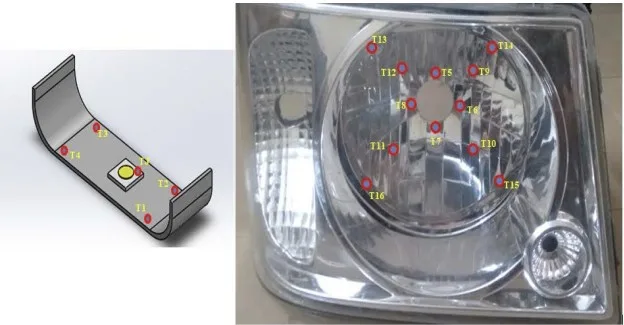1.概要:
- 論文タイトル: AUTOMOTIVE HEADLAMP HIGH POWER LED COOLING SYSTEM AND ITS EFFECT ON JUNCTION TEMPERATURE AND LIGHT INTENSITY
- 著者: Ramesh Kumar Chidambaram¹、Rammohan Arunachalam¹
- 発行年: 2020年
- 発行誌/学会: Journal of Thermal Engineering
- キーワード: HPLED冷却システム、HPLED接合部温度、ヘッドライト反射鏡温度、ハロゲン、光強度
2. 研究背景:
自動車のヘッドライトは、夜間走行時の安全と車両の外観に重要な役割を果たします。従来はハロゲンランプとキセノンランプが主流でしたが、ハロゲンランプは効率が低く発熱量が多いという欠点があり、キセノンランプは点灯時間が長いという欠点がありました。高出力LED(HPLED)はエネルギー効率が高く、寿命が長いという利点がありますが、従来のヘッドライトアセンブリはHPLEDの発熱対策に適しておらず、装着すると過熱による寿命短縮の問題が発生します。そのため、自動車用途におけるHPLEDの効率的な熱管理システムの開発が求められています。
3. 研究目的と研究課題:
- 研究目的: 従来のヘッドライトアセンブリにHPLED用のコンパクトな冷却システムを開発し、接合部温度と光強度への影響を評価すること。
- 主要な研究課題: コンパクトな冷却システムは、HPLEDの接合部温度と光強度をどのように変化させるか?
- 研究仮説: コンパクトな冷却システムを使用することで、HPLEDの接合部温度が低下し、光強度が向上する。
4. 研究方法:
- 研究デザイン: 実験計画とシミュレーションを組み合わせた研究手法を採用。ANSYSソフトウェアを用いて様々なサイズのヒートシンクをモデリングおよびシミュレーションし、最適なヒートシンクの寸法を決定しました。
- データ収集方法: 実験は、人気のSUV車種のヘッドライトアセンブリを用いて、外部照明のない黒色の平面から約28メートルの距離で行われました。光強度はルクス(lux)単位で測定され、温度は熱電対を使用して測定されました。
- 分析方法: ANSYSシミュレーションの結果に基づき、最適なヒートシンクを選定し、実験結果を統計的に分析しました。また、HPLEDの接合部温度と光強度の変化を分析しました。
- 研究対象と範囲: 人気のSUV車種のヘッドライトアセンブリを使用し、55Wハロゲンバルブと16W HPLEDを比較分析しました。冷却ファンの風速を変化させて実験を行いました。
5. 主要な研究結果:
- 主要な発見: 提案されたコンパクトな冷却システムを使用することで、HPLEDの接合部温度は約25%低下し、光強度は約30.9%向上しました。HPLEDヘッドライトのリフレクター内壁温度は、ハロゲンバルブに比べて49%低くなりました。同じ光強度を得るために、HPLEDはハロゲンバルブの1/3のエネルギーしか消費しません。
- 統計的/定性的分析結果: ANSYSシミュレーションにより最適なヒートシンクサイズを決定し、実験データから接合部温度と光強度の変化を測定しました。様々な風速における接合部温度の変化を分析しました。レイノルズ数に基づいて空気の流れの状態を分析しました。
- データ解釈: 冷却ファンの風速が速くなるほど、HPLEDの接合部温度は低下し、光強度は向上する傾向が見られました。接合部温度が1℃低下すると、特定の測定点における光強度は2.7ルクス向上しました。
- 図表リストと説明: 論文には多数の図表(図1~図12)が含まれており、実験装置、測定点、温度分布、光強度、冷却システムの性能などを示しています。

6. 結論と考察:
コンパクトな冷却システムを採用したHPLEDヘッドライトは、従来のハロゲンランプに比べてエネルギー効率が高く、寿命が長く、光強度が高いという利点があります。この研究結果は、HPLEDヘッドライトの設計と熱管理システムの開発に役立つ情報を提供します。本研究は、実際の車両環境を完全に再現したものではありませんが、実験結果はHPLEDの熱管理に関する重要な示唆を与えてくれます。
7. 今後の研究:
本研究は、実際の車両環境を完全に再現したものではないため、より現実的な走行環境下での追加実験が必要です。様々なHPLEDや冷却システムに関する研究が必要であり、より精緻な熱モデル化とシミュレーション手法を開発することで、研究の精度を高めることができます。
8. 参考文献:
論文では、LEDの熱管理と自動車用照明に関する多くの研究論文が参考文献として引用されており、既存の研究結果との比較分析を通じて、本研究の結果を裏付けています。
- [1] Sousa JMM, Vogado J, Costa M, Bensler H, Freek C, Heath D. An experimental investigation of fluid flow and wall temperature distributions in an automotive headlight. International Journal of Heat and Fluid Flow 2005;26:709–21. https://doi.org/10.1016/j.ijheatfluidflow.2005.05.003.
- [2] Weng CJ. Advanced thermal enhancement and management of LED packages. International Communications in Heat and Mass Transfer 2009;36:245–8. https://doi.org/10.1016/j.icheatmasstransfer.2008.11.015.
- [3] Tsai MY, Chen CH, Kang CS. Thermal measurements and analyses of low-cost high-power LED packages and their modules. Microelectronics Reliability 2012;52:845–54. https://doi.org/10.1016/j.microrel.2011.04.008.
- [4] Jung ED, Lee YL. Study on the development of LED headlamps for used cars. Transactions on Electrical and Electronic Materials 2014;15:270–4. https://doi.org/10.4313/TEEM.2014.15.5.270.
- [5] Kaya M. Experimental Study on Active Cooling Systems Used for Thermal Management of High-Power Multichip Light-Emitting Diodes. Scientific World Journal 2014;. http://dx.doi.org/10.1155/2014/563805.
- [6] Wang J, Zhao X, Cai Y, Zhang C, Bao W. Experimental study on the thermal management of high-power LED headlight cooling device integrated with thermoelectric cooler package. Energy Conversion and Management 2015;101:532–40. https://doi.org/10.1016/j.enconman.2015.05.040.
- [7] Sökmen KF, Yürüklü E, Yamankaradeniz N. Computational thermal analysis of cylindrical fin design parameters and a new methodology for defining fin structure in LED automobile headlamp cooling applications. Applied Thermal Engineering 2016;94:534–42. https://doi.org/10.1016/j.applthermaleng.2015.10.069.
- [8] Niculina BD, Paul S, Cristina M. Fan vs. Passive heat sinks for cooling high power COB-type LEDs. Proceedings of the 9th International Conference on Electronics, Computers and Artificial Intelligence, ECAI 2017 2017;2017-Janua:1–4. https://doi.org/10.1109/ECAI.2017.8166477.
- [9] Sufian SF, Fairuz ZM, Zubair M, Abdullah MZ, Mohamed JJ. Thermal analysis of dual piezoelectric fans for cooling multi-LED packages. Microelectronics Reliability 2014;54:1534–43. https://doi.org/10.1016/j.microrel.2014.03.016.
- [10] Singh R, Jalilvand A, Goto K, Mashiko K, Saito Y, Mochizuki M. Direct impingement cooling of LED by Piezo fan. 2014 International Conference on Electronics Packaging, ICEP 2014 2014:1–5. https://doi.org/10.1109/ICEP.2014.6826650.
- [11] Fu HK, Wang CP, Chiang HC, Chen T Te, Chen CL, Chou PT. Evaluation of temperature distribution of LED module. Microelectronics Reliability 2013;53:554–9. https://doi.org/10.1016/j.microrel.2012.11.009.
- [12] Maaspuro M, Tuominen A. Microelectronics Reliability Thermal analysis of LED spot lighting device operating in external natural or forced heat convection. Microelectronics Reliability 2013;53:428–34. https://doi.org/10.1016/j.microrel.2012.10.004.
- [13] Wang J, Cai YX, Zhao XJ, Zhang C. Thermal design and simulation of automotive headlamps using white LEDs. Microelectronics Journal 2014;45:249–55. https://doi.org/10.1016/j.mejo.2013.11.011.
- [14] Su YF, Yang SY, Hung TY, Lee CC, Chiang KN. Light degradation test and design of thermal performance for high-power light-emitting diodes. Microelectronics Reliability 2012;52:794–803. https://doi.org/10.1016/j.microrel.2011.07.059.
- [15] Shih K. LED Junction Temperature Measurement and its Applications to Automotive Lamp Design. SAE Technical Paper 2004. https://doi.org/10.4271/2004-01-0224.
- [16] Colaco AM, Kurian CP, Kini SG, Colaco SG, Johny C. Thermal characterization of multicolor LED luminaire. Microelectronics Reliability 2017;78:379–88. https://doi.org/10.1016/j.microrel.2017.04.026.
- [17] J. P. Holman. Experimental methods for engineers. 8th ed. McGrawHill; 2012.
- [18] Lampio K, Karvinen R. Optimization of convectively cooled heat sinks. Microelectronics Reliability 2017;79:473–9. https://doi.org/10.1016/j.microrel.2017.06.011.
- [19] Rammohan A, Kumar Ramesh C. A review on effect of thermal factors on performance of high power light emitting diode (HPLED). Journal of Engineering Science and Technology Review 2016;9:165-76. https://doi.org/10.25103/jestr.094.24.
- [20] Dongmei Zhou and Timothy Rau. Thermal design methodology and prediction of heat sink performance. Journal of Thermal Engineering 2016;2:826–36. https://doi.org/10.18186/jte.29129.
- [21] Abu M, Alt V. The Effect of Blowing Direction on Heat Sink Performance. Journal of Thermal Engineering 2018;4:2471–80 2018;4:2471–80. https://doi.org/10.18186/thermal.465695.
著作権:
この要約は、Ramesh Kumar ChidambaramとRammohan Arunachalamによる論文「AUTOMOTIVE HEADLAMP HIGH POWER LED COOLING SYSTEM AND ITS EFFECT ON JUNCTION TEMPERATURE AND LIGHT INTENSITY」に基づいて作成されました。
この資料は上記の論文に基づいて要約を作成したものであり、商業目的での無断使用を禁じます。
Copyright © 2023 CASTMAN. All rights reserved. (西暦を修正)